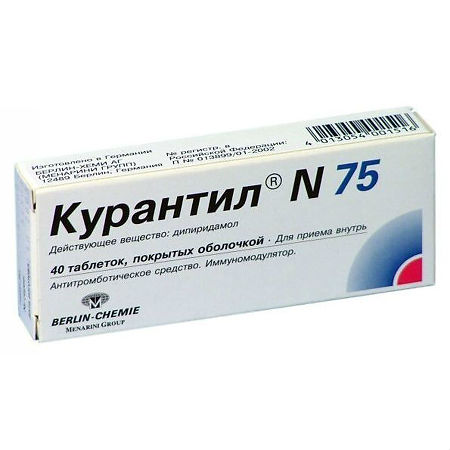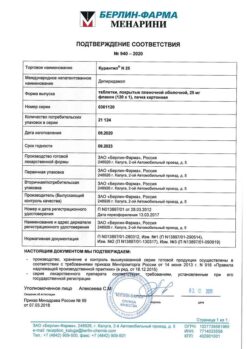No products in the cart.
Curantil N75, 75 mg 40 pcs
€31.46 €26.21
Description
Pharmacodynamics
A myotropic vasodilator. It has an inhibitory effect on platelet aggregation, improves microcirculation.
Dipyridamole dilates arterioles in the coronary blood flow system, and in other parts of the circulatory system when taken in high doses. However, unlike organic nitrates and calcium antagonists, dilation of larger coronary vessels does not occur.
The vasodilator effect of dipyridamole is due to two different mechanisms of inhibition: inhibition of adenosine uptake and inhibition of phosphodiesterase.
In vivo, adenosine is detected at a concentration of approximately 0.15-0.20 μmol. This level is maintained due to a dynamic equilibrium between release and reuptake.
Dipyridamole inhibits the uptake of adenosine by endothelial cells, red blood cells and platelets. After dipyridamole administration, an increase in blood concentration of adenosine and an increase in adenosine-induced vasodilation are found. At higher doses, adenosine-induced platelet aggregation is inhibited and the propensity to thrombosis decreases.
The breakdown of cAMP and cGMP, which inhibit platelet aggregation, occurs in platelets under the action of the corresponding phosphodiesterases. In high concentrations, dipyridamole inhibits both phosphodiesterases, in therapeutic concentrations in blood – only cGMP-phosphodiesterase. As a result of stimulation of the corresponding cyclases the capacity of the synthesis of cAMP increases.
As pyrimidine derivative, dipyridamole is an interferon inducer and has modulatory effect on functional activity of interferon system, increases decreased production of interferon alpha and gamma by blood leukocytes in vitro. The drug increases nonspecific resistance to viral infections.
Pharmacokinetics
Intake and distribution
. After a single oral dose of 150 mg, the Cmax of dipyridamole in plasma averages 2.66 µg/L and is reached within 1 hour of ingestion.
Dipyridamole is almost completely bound to plasma proteins. Dipyridamole accumulates in the heart and red blood cells.
Metabolism and excretion
Dipyridamole is metabolized in the liver by binding to glucuronic acid. T1/2 is 20-30 min. It is excreted with the bile as monoglucuronide.
Indications
Indications
Active ingredient
Active ingredient
Composition
Composition
Active substances:
dipyridamole 75 mg
Associated substances:
corn starch – 33.75 mg,
lactose monohydrate – 12.5 mg,
sodium carboxymethyl starch (type A) – 3.75 mg,
gelatin – 2.5 mg,
colloidal anhydrous silica – 1.25 mg,
magnesium stearate – 1.25 mg.
The composition of the film coating:
Hypromellose – 0.9 mg,
talc – 0.4 mg,
macrogol 6000 – 0.12 mg,
titanium dioxide (E171) – 0.1 mg,
quinoline yellow dye (E104) – 0.01 mg,
simethicone emulsion – 0.002 mg.
How to take, the dosage
How to take, the dosage
The dose of the drug is chosen depending on the severity of the disease and the individual response of the patient.
In case of CHD, it is recommended to take 75 mg 3 times a day. If necessary, the daily dose can be increased under medical supervision.
For the prevention and treatment of cerebral circulatory disorders, as well as for prophylaxis, 75 mg 3-6 times a day is prescribed. The maximum daily dose is 450 mg.
To reduce platelet aggregation, Courantil is prescribed in a dose of 75-225 mg/day in several doses. In severe cases, the dose may be increased to 600 mg/day.
For prevention of flu and acute respiratory viral infections, especially during epidemics, Courantil N25 and Courantil 25 are prescribed in 50 mg (2 tablets or 2 pills)/day in 1 dose. The drug is taken once a week for 4-5 weeks.
In prophylaxis of recurrent ARVI in patients who have often had respiratory viral infections Courantil N25 and Courantil 25 are prescribed in dose 100 mg/day (2 tablets or 2 tablets/drags 2 times/day with 2 hours interval between doses). The drug is taken once a week for 8-10 weeks.
The tablets should be taken on an empty stomach, without breaking or biting, with a small amount of liquid. The duration of the course of treatment is determined by the doctor.
Interaction
Interaction
Concomitant use of Curantil with anticoagulants or acetylsalicylic acid increases the antithrombotic effect of the latter and therefore the risk of hemorrhagic complications.
When used concomitantly, Courantil increases the effect of antihypertensive drugs.
When used concomitantly, Courantil may weaken the anticholinergic effects of cholinesterase inhibitors.
When used concomitantly, xanthine derivatives weaken the vasodilatory effects of Courantil.
Special Instructions
Special Instructions
In the simultaneous use of tea or coffee (containing xanthine derivatives) the vasodilator effect of Curantil may decrease.
Pediatric use
Kurantil is not recommended for children under 12 years of age due to lack of sufficient clinical experience in its use.
Impact on ability to drive vehicles and other mechanisms requiring increased concentration
Perhaps caution should be exercised when driving vehicles and operating machinery because due to BP decrease during taking Curantil, ability to concentrate and quick psychomotor reactions may be impaired.
Contraindications
Contraindications
Side effects
Side effects
Cardiovascular system disorders: palpitations, tachycardia (especially with concomitant use of other vasodilators), bradycardia, facial flushes, facial hyperemia, coronary cirrhosis syndrome (when using the drug in a dose greater than 225 mg/day), BP decrease.
Digestive system disorders: nausea, vomiting, diarrhea, epigastric pain. Usually these side effects disappear with longer use of the drug.
With the clotting system: thrombocytopenia, change of functional properties of platelets, bleeding; in single cases – increased bleeding during or after surgical intervention.
CNS disorders: dizziness, head noise, headache.
Allergic reactions: skin rash, urticaria.
Others: weakness, feeling of tightness in the ear, arthritis, myalgia, rhinitis.
When the drug is used in therapeutic doses, the side effects are usually mild and transient.
Overdose
Overdose
Symptoms: decreased BP, angina pectoris, tachycardia, hot flashes, weakness and dizziness.
Treatment: artificial vomiting, gastric lavage, administration of activated charcoal. Vasoconstrictor effect of the drug can be stopped by slow (50-100 mg/min) IV administration of aminophylline. If symptoms of angina persist, administration of nitroglycerin sublingually.
Pregnancy use
Pregnancy use
The drug may be used in pregnancy when indicated.
The use of the drug during lactation is possible only if the expected benefits of treatment exceed the possible risks.
Similarities
Similarities
Additional information
| Shelf life | 3 years |
|---|---|
| Conditions of storage | At a temperature not exceeding 30 °C |
| Manufacturer | Berlin-Pharma, Russia |
| Medication form | pills |
| Brand | Berlin-Pharma |
Other forms…
Related products
Buy Curantil N75, 75 mg 40 pcs with delivery to USA, UK, Europe and over 120 other countries.














